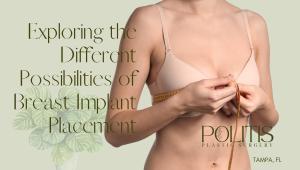KEY TAKEAWAYS:
- Enhanced recovery protocols can significantly reduce pain and discomfort after breast reconstruction surgery.
- These protocols involve a multimodal approach, including anesthesia, nerve blocks, and supportive scaffolding for the implant.
- Dr. Effie Politis and her team at Politis Plastic Surgery in Tampa, FL, are dedicated to providing the highest level of care for breast reconstruction patients, including long-term monitoring and support.
Introduction
Breast reconstruction surgery is an essential procedure for many women who have undergone mastectomy or lumpectomy due to breast cancer. However, postoperative pain management is a significant concern for patients undergoing this surgery. Dr. Effie Politis, a plastic surgeon in Tampa, FL, has been using enhanced recovery protocols after surgery to help her patients recover with minimal pain and discomfort. In this article, we will explore how these protocols can benefit patients undergoing breast reconstruction surgery.
Enhanced Recovery Protocols in Breast Reconstruction
Enhanced recovery protocols involve a multimodal approach to pain management and recovery, including the use of anesthesia, nerve blocks, and supportive scaffolding for the implant. By working closely with anesthesiologists and breast surgeons, Dr. Politis is able to provide her patients with a comprehensive recovery plan that minimizes pain and maximizes comfort.
Short Hospital Stays and Minimal Pain Medication
Patients who undergo breast reconstruction surgery with enhanced recovery protocols typically stay in the hospital for only one night, and some may even go home the same day. Most patients require minimal pain medication, with many opting for over-the-counter pain relievers such as Advil and Tylenol. This is a testament to the effectiveness of the enhanced recovery protocols in managing postoperative pain.
Supportive Scaffolding for Long-Term Stability
Dr. Effie Politis uses advanced supportive scaffolding materials to ensure the long-term stability of the breast implant. These materials, which can be synthetic or organic, eventually disappear and are replaced by the patient’s own type 1 collagen. Fat grafting may also be used to address any palpable abnormalities, further improving the overall aesthetic result.
Long-Term Care and Monitoring
At Politis Plastic Surgery in Tampa, FL, Dr. Effie Politis and her team are dedicated to providing long-term care and monitoring for their breast reconstruction patients. By following patients long-term, they can address any issues or changes that may arise due to factors such as weight gain, pregnancy, or aging.
Politis Plastic Surgery: Expert Care for Breast Reconstruction Patients
At Politis Plastic Surgery in Tampa, FL, Dr. Effie Politis and her team are committed to providing the highest level of care for breast reconstruction patients. With a focus on personalized treatment plans and the use of enhanced recovery protocols, Politis Plastic Surgery ensures that every individual receives the best possible outcome in their breast reconstruction journey, with minimal pain and discomfort.
TRANSCRIPTION:
Hi, my name is Dr. Effie Politis with Politis Plastic Surgery.
So my patients have been recovering great, again using enhanced recovery protocols after
surgery.
The first surgery is always the toughest.
They undergo the bilateral mastectomies, but because I work with the anesthesiologist and
I do my own blocks, the breast surgeons do blocks, it’s a multimodal approach.
They stay in the hospital typically one night or some of them go home.
This is all assessed prior and usually I only write for three pain pills and some of them
don’t take any of that.
They just are able to tolerate Advil and Tylenol, minimal nausea and vomiting and again the
pain is more of a soreness or working out pain, not excruciatingly painful.
Again we have great supportive scaffolding that can be placed to hold that implant in
place long term.
So these are synthetic materials, but they’re organic in the sense that they disappear and
are replaced by the patient’s own type 1 collagen.
We also can use cadaveric dermis.
We have options of fat grafting for any palpable abnormalities and I kind of go through this
with the patient at the initial consultation, but there are patients that we follow long
term.
So we certainly readdress any issues and again they’re with us long term.
We offer the patient that service because as we know with implants, there certainly
are going to be changes in the patient’s body, perhaps weight gain, weight gain.
Some of these patients still have children, they’re in childbearing age, so we do like
to follow our patients long term.
REFERENCES:
- “Lumpectomy – Mayo Clinic.” 8 Nov. 2022, https://www.mayoclinic.org/tests-procedures/lumpectomy/about/pac-20394650.
- “Enhanced Recovery after Surgery – AANA.” https://www.aana.com/practice/clinical-practice-resources/enhanced-recovery-after-surgery.
- “How Galatea 3D Scaffolds Can Improve Your Breast Surgery.” 29 Apr. 2020, https://howlandplasticsurgery.com/how-galatea-3d-scaffolds-can-improve-your-breast-surgery/.



 Deciding on the
Deciding on the 
 Breast augmentation is a type of plastic surgery performed to enhance the size and shape of one’s breasts. Generally, the procedure is utilized to improve self-image and self-confidence. During the procedure, a
Breast augmentation is a type of plastic surgery performed to enhance the size and shape of one’s breasts. Generally, the procedure is utilized to improve self-image and self-confidence. During the procedure, a 
 Breast augmentation
Breast augmentation

 Breast augmentation is one of the most commonly performed
Breast augmentation is one of the most commonly performed 

 It is estimated that hundreds of thousands of women in the U.S. choose to have
It is estimated that hundreds of thousands of women in the U.S. choose to have 
 Breast augmentation
Breast augmentation